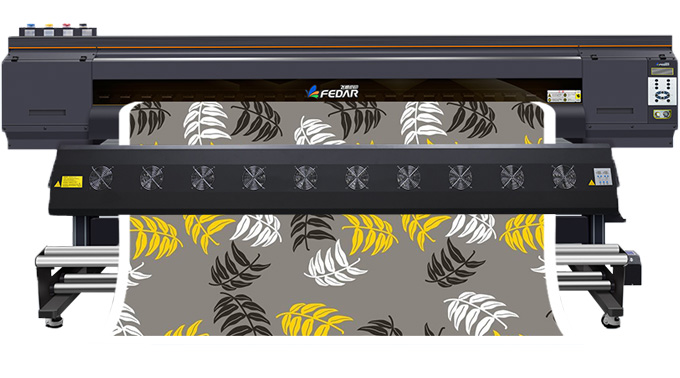When printing,
fedar heat transfer printer head does not emit ink, resulting in lack of color in the picture, which is usually referred to as "nozzle clogging", which is the main factor affecting picture quality. So why is the nozzle blocked? There are roughly the following situations:

1. After the ink accumulates to a certain extent,fedar heat transfer printer nozzle will be blocked on the outside. This is the most common clogging method. The solvent in the ink must be volatilized into the air to make the screen dry. Because the ink is a volatile liquid, it is easy to volatilize in the air and clear solids. When the nozzle is spraying on the material, there will always be a part of the ink around it. After this part of the ink is dried in the air, the nozzle will gradually become smaller and even block the nozzle. But because it is outside nozzle, it is easy to clean.
2. The piezoelectric crystal of fedar heat transfer printer is damaged. The general piezoelectric nozzle can be used for about a year, and it is normal that it may be used for less than a year in a factory with a lot of inkjet work.
3.Fatigue damage of fedar heat transfer printer’s piezoelectric crystal. The phenomenon is that the nozzle sometimes ejects ink and sometimes does not eject, especially when the inkjet volume is large (that is, when printing dark pictures), the "clogging" phenomenon is obvious. At this time, the best way is to replace a new printhead.
4. The filter inside fedar heat transfer printer head is blocked, causing the nozzle to not emit ink. Especially in factories that often shut down at night. The ink does not flow in nozzle for a long time, and it is easy to be adsorbed on the inner filter screen or the wall of the ink channel, so that the cross-sectional area of ink flow becomes smaller, and the nozzle does not emit ink.
5. The viscosity of the ink is too high or too low. The viscosity of the ink is too high, which makes the ink fluidity poor, and the amount of ink ejected by the nozzle per unit time is not enough; the viscosity of the ink is too low, and it is easy to inhale air when the piezoelectric crystal in the nozzle hole is drawn back, and the ink cannot be sucked,but the air.
6.Failure of fedar heat transfer printer ‘s drive circuit.The aging of the electronic components of the drive circuit and the accumulation of too much dry ink dirt may affect the voltage of the drive nozzle, resulting in no ink or unstable ink output.
7. Types of ink: Due to improper control of the amount of desiccant, the ink of some manufacturers dries too quickly, which easily causes the ink to be clogged outside. Although it can be cleaned, the cleaning interval is relatively frequent. Once printhead is not used for a long time and is not timely protecting the print head, it may cause permanent damage to the print head.
8. Frequent ink replacement: In many cases, the nozzle may not be protected properly when replacing the ink, which will also affect the inkjet status of the fedar heat transfer printer head.
9. The temperature and humidity of the environment where fedar heat transfer printer is used. It is generally recommended that the temperature is 22-25 degrees, and the humidity is 35-65%. High and low temperatures affect the viscosity of the ink, which will cause the ink shortage of printhead, which is often mistaken for "nozzle clogging" ".
10. Nozzle driving voltage: A suitable printhead voltage will make the ink more smoothly.



